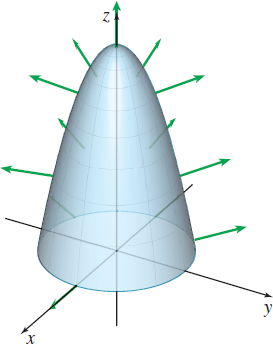EXAMPLE 4Finding the Orientations of a Surface
Find both orientations for the paraboloid defined by z=9−x2−y2, z≥0.
- (a) Use rectangular coordinates to find the unit normal vectors.
- (b) Parametrize the surface, and then find the unit normal vectors.
Solution (a) Since the paraboloid is given by f(x,y)=9−x2−y2,z≥0, we can use the equations (3) and (4) to find the unit normal vectors. We begin by finding the partial derivatives fx(x,y)=−2xfy(x,y)=−2y
Then n=2xi+2yj+k√[−2x]2+[−2y]2+1=2xi+2yj+k√4x2+4y2+1−n=−2xi−2yj−k√[−2x]2+[−2y]2+1=−2xi−2yj−k√4x2+4y2+1
Notice that the k component of n is positive, indicating n is the upward-pointing unit normal vector.
(b) We parametrize z=9−x2−y2, z≥0, using cylindrical coordinates, by defining the parametric equations x=rcosθy=rsinθz=9−(x2+y2)=9−r2
Then the parametrization is r=r(r,θ)=rcosθi+rsinθj+(9−r2)k
We seek ‖. The partial derivatives of \mathbf{r} are \begin{eqnarray*} \mathbf{r}_{r}&=&\cos \theta \,\mathbf{i}+\sin \theta \,\mathbf{j}-2r\mathbf{k} \qquad \mathbf{r}_{\theta }=-r\sin \theta \,\mathbf{i}+r\cos \theta \,\mathbf{j}\\[4pt] \mathbf{r}_{r}\times \mathbf{r}_{\theta } &=& \left|\begin{array}{c@{\quad}c@{\quad}c} \mathbf{i} & \mathbf{j} & \mathbf{k} \\[3pt] \cos \theta & \sin \theta & -2r \\[3pt] -r\sin \theta & r\cos \theta & 0 \end{array}\right| =2r^{2}\cos \theta\, \mathbf{i}+2r^{2}\sin \theta\, \mathbf{j}+r\mathbf{k} \\[4pt] \left\Vert \mathbf{r}_{r}\times \mathbf{r}_{\theta }\right\Vert &=&\sqrt{ 4r^{4}\cos ^{2}\theta +4r^{4}\sin ^{2}\theta +r^{2}}=\sqrt{4r^{4}+r^{2}}=r \sqrt{4r^{2}+1} \end{eqnarray*}
The unit normal vectors are \begin{eqnarray*} \mathbf{n}&=&\dfrac{\mathbf{r}_{r}\times \mathbf{r}_{\theta }}{\left\Vert \mathbf{r}_{r}\times \mathbf{r}_{\theta }\right\Vert }=\dfrac{2r^{2}\cos \theta\, \mathbf{i}+2r^{2}\sin \theta\, \mathbf{j}+r\mathbf{k}}{r\sqrt{4r^{2}+1}} =\dfrac{2r\cos \theta\, \mathbf{i}+2r\sin \theta\, \mathbf{j}+\mathbf{k}}{\sqrt{ 4r^{2}+1}}\\[4pt] -\mathbf{n}&=&\dfrac{-2r\cos \theta\, \mathbf{i} -2r\sin \theta\, \mathbf{j}-\mathbf{k}}{\sqrt{4r^{2}+1}} \end{eqnarray*}

Notice that the unit vectors found in (a) and (b) are equivalent.